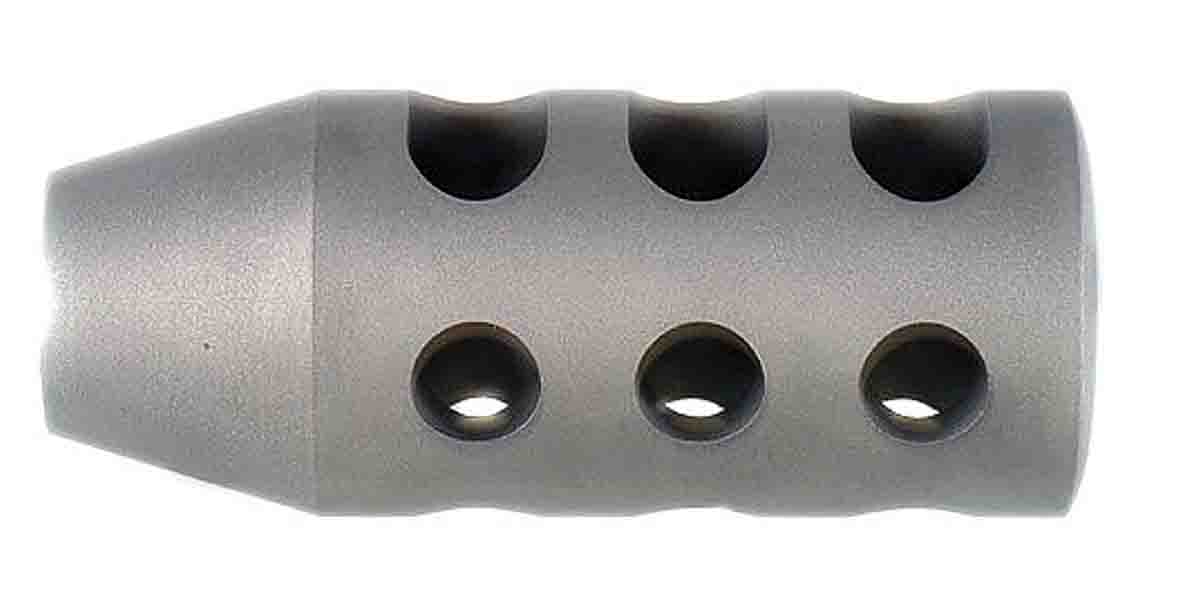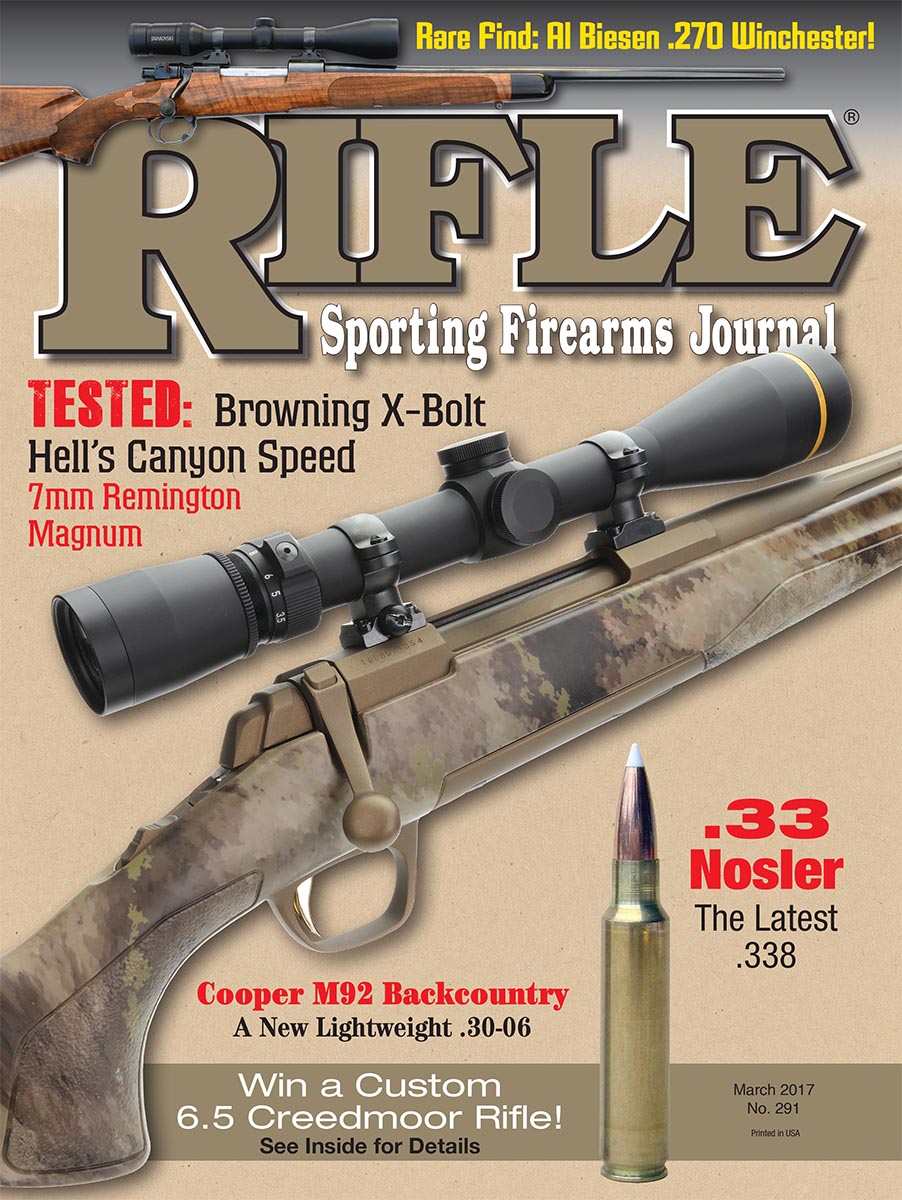Spotting Scope
Muzzle Brakes
column By: Dave Scovill | March, 17
Upon receiving an invite to hunt desert mule deer in Sonora, Mexico, a few days before Christmas, the first question that came to mind was whether or not the Mexican authorities would have enough time during the coming holidays to process the paper work required to take a rifle south of the border. Since the chance of acquiring a “permission” paper at such a time would be doubtful, I asked about a “camp” rifle.

As luck would have it, two rifles would be available at the ranch, a Winchester Model 70 .300 Winchester Magnum and a Tikka .300 Winchester Short Magnum. Both rifles were quite acceptable – although a bit much for deer-sized game – assuming there would be an opportunity to shoot them prior to hunting, and arrangements were made for the hunt.
Uncasing the rifles at the ranch, the Model 70 was familiar to me. It was used by my friend Dr. Mike Poulos to take a fair number of Sonoran mule deer and whitetail. What I had forgotten was that it had a muzzle brake. The Tikka turned out to be a lightweight stainless steel short action with a synthetic stock. Both rifles proved capable of fine accuracy when fired from an impromptu benchrest at 100 long paces, so the choice was boiled down to the lightweight with the rock-hard buttpad that kicked like a mule or the relative heavyweight with a muzzle brake that produced obnoxious muzzle blast but the recoil of a .243 Winchester.
Since Dr. Mike had mounted a custom scope calibrated to 1,000 yards for the Barnes factory loads on hand for the Model 70, I decided to give it a try, at least for the time being, just in case a big buck offered a reasonable shot out to 500 yards or so, maximum. I was still leery of the muzzle brake, however, since my hearing had just about had enough of magnum-grade muzzle blast.
Several years ago the late Wolfe Publishing editor Al Miller launched an effort to find a muzzle brake that tamed the big-bore blasters but that might also reach some sort of happy medium in terms of muzzle blast. Unfortunately, such a device, from Al’s tests, simply did not exist, albeit one outfit did advertise a “silent brake.” At the time, I advised Al that I would not be prone to find out if the claim was true by firing more than one shot without earplugs and muffs, and that shot would not be fired under cover at the Prescott Sportsman Club range or any other covered range. I also reminded Al that the range master at the then-named Black Canyon Shooting Range north of Phoenix would not allow muzzle brakes on the line . . . period.
Eventually Al gave up on the quest to find an acceptable muzzle brake, and I avoided them like a toxic plague until Winchester/Browning came up with the BOSS (Ballistic Optimizing Shooting System), a muzzle brake that was calibrated to encourage the user to turn the adjustment in or out in an attempt to “dial in” best accuracy. Turning the BOSS in relatively small increments between groups failed to produce acceptable accuracy for a dozen or so three-shot groups, whereupon it was cranked several full turns to extend the brake a full .5 inch or so, and “bingo,” .3-inch, three-shot clusters appeared. After shooting a couple of whitetail deer, a few feral hogs, a nilgai and a coyote in the field sans ear protection, however, my ears were still ringing when we left Texas, and the rifle was returned to Morgan, Utah, posthaste.
The next muzzle brake on a Savage All Weather Rifle .300 Winchester Magnum could be turned off and on. The concept made good sense, but the question was whether or not it would hold zero and accuracy when turned on and off, or vice versa. It was assumed the brake would reduce recoil to some degree.
The Savage rifle proved to shoot quite well at the outset, and subsequent tests with the brake turned on and off didn’t appear to have a measurable effect on accuracy. Probably of more interest to most shooters, however, is that the open brake proved to turn the rifle into a pussycat, which in the real world, assuming a decent recoil pad, is the only reason to even consider a muzzle brake. With that realization, I bought the rifle and gave it to my step-son, with the caution “earplugs required” in the field and both plugs and muffs on the range whether the brake is on or off.
Aside from muzzle blast, I have also seen a few shooters who have developed a terrible flinch from the loud noise and concussion. The worst was a 7mm Weatherby Magnum a friend used in Africa, and I soon learned to keep my distance – 15 to 20 yards – when he was shooting. He also had acquired a bad flinch. Additionally, most professional hunters, guides and outfitters have learned to back off when the client shoots and, if asked, would probably suggest a thicker and/or more efficient recoil pad vice the brake if stout recoil tolerance is an issue.
For my part, a folded towel abates recoil over long sessions at the bench, especially when being pounded by the crescent-steel buttplates on .45 and larger caliber Winchester lever actions that toss 450-grain bullets at upwards of 2,100 fps. In the field, harsh recoil usually goes unnoticed, and most folks develop a flinch while shooting from a bench setup. I also noticed, when sitting off the firing line at a public range several years ago in Phoenix, most folks who develop a flinch aren’t aware of it or won’t admit they do it, or both.
On the hunt in Sonora last week as this was written, I fired Dr. Mike’s .300 Winchester Magnum three times in the field. The first two shots at a couple of coyotes produced a bit of ringing in my ears after the second shot. The third shot, fired a day later, did not appear to have a cause/effect. I’m guessing, but that 22-inch barrel on the Tikka would likely produce a rather loud report to the unprotected ears as well, in addition to a rather bright muzzle flash that I did not notice with the belted .300.
On the drive to Prescott from Tucson, I slipped an Eagles CD into the player at the top of the ascent to Sunset Point on I-17. My ears popped a couple of times as I throttled back on the Hemi a bit and slipped past a high-balling 18-wheeler with Glenn Frey’s classic lyric “. . . I’m a-standin’ on a corner in Winslow, Arizona. Such a fine sight to see. . . .” My hearing seemed just fine.
Newton’s Third Law
Sir Isaac Newton’s third law states that for every action there is an equal and opposite reaction. Applied to firearms, that means the air in front of a bullet, the bullet and the combustion gases behind the bullet are set in motion by ignition of the gun powder. The forward acceleration of the combined mass (ejecta) composed of the air, bullet and combustion gas, includ- ing powder residue, creates an opposite reaction defined as recoil.
The function of a muzzle brake is to release the air and gas to the side at roughly a 90-degree or less angle, effectively reducing the jet effect of the accelerating mass that would normally occur as it exits the muzzle of the barrel against the opposing atmosphere. By reducing the force created by the ejecta mass at the muzzle, a muzzle brake reduces the opposing force, recoil.
The effectiveness of a muzzle brake depends on the number and size of the holes drilled around and along the length of the tubular-shaped brake. Most bleed gas off at roughly a 90-degree angle, while some designs feature holes at a slight rearward angle to oppose the recoil action but toward the shooter’s head and, unfortunately, his or her ears.
There has been some debate over the years regarding the net effectiveness of muzzle brakes, which is largely affected by the weight of the individual firearm. Even without a brake, heavy guns recoil less than lighter designs, assuming they both fire identical ammunition.


